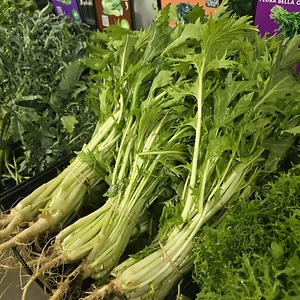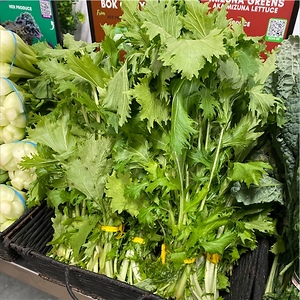


Mizuna Lettuce
Estimated Inventory, 3 lbs : 0
Description/Taste
Mizuna is small to medium in size, averaging 35-40 centimeters in height, and grows in bunches from a central stalk with long stems. The dark green leaves are smooth, have a glossy surface, bear deeply serrated edges, and have a fringed, feathery appearance. The thin, narrow, and white stems are firm and offer a crunchy texture. Mizuna is harvested at both the baby and mature stages, with the younger leaves being more tender and milder, and the mature leaves being crisp with a peppery, piquant, and mildly bitter-sweet taste.
Seasons/Availability
Mizuna is available year-round, with peak seasons in the spring and fall.
Current Facts
Mizuna, botanically classified as Brassica juncea, is a leafy green belonging to the Brassicaceae or mustard family. Also known as Japanese mustard greens, Spider mustard, Kyona, Qian Jing Shui Cai, and California peppergrass, Mizuna is a fast-growing winter green and its name in Japanese means “water greens” after the flooded fields in which they grow. They are one of the few vegetables native to Japan and are designated as a protected heirloom vegetable in Kyoto. There are over sixteen different varieties of Mizuna, and these greens are most commonly grown for commercial salad mixes.
Nutritional Value
Mizuna is a nutrient-dense leafy green and is high in vitamins A, C, and K, folate, and iron. It is also a source of B-complex vitamins and the essential minerals calcium, magnesium, manganese, potassium, zinc, and selenium.
Applications
Mizuna greens are best suited for both raw and cooked applications such as steaming, stir-frying, or boiling. The leaves are most often used in salad mixes, specifically mesclun or spring mix, and pairs well with sharp, peppery lettuces and other bitter greens. The leaves can also add a mild bitterness and crunch to cold or hot pasta dishes, quinoa, pizza, or risotto. Substitute Mizuna in salads that call for frisee, such as frisee aux lardon. When using in hot dishes, the leaves should be added at the end of cooking so the leaves can wilt and like spinach, will shrink when cooked. Mizuna can also be used in stir-fries, soups, or sautés, where the leaves will soak up some of the flavoring liquid. Mizuna pairs well with parmesan, goat cheese, arugula, spinach, bok choy, mushrooms, garlic, ginger, green onions, parsley, miso soup, chicken noodle soup, noodles, vinaigrettes, farro, barley, pork chops, poultry, tofu, pear, pecans, and sauces such as lemon, ponzu, and soy sauce. The leaves will keep up to five days when wrapped loosely and stored in the crisper drawer of the refrigerator.
Ethnic/Cultural Info
In Japan, Mizuna is one of several vegetables known as ‘Kyo yasai’ or ‘Kyo-no-dento-yasai’ which refers to heirloom vegetables traditionally grown in Kyoto. These different vegetables have been grown in Kyoto, once the center of politics and culture in Japan, since the 18th and early 19th centuries. Mizuna was grown in the area around the Mibu-Dera temple in the southern region of Kyoto, where natural springs helped with irrigation efforts and kept the fields wet for the greens to thrive. Today Mizuna is still used in Japanese cooking and is most commonly pickled in a simple brine of salt or with other sea vegetables. It is also added to hot pot, known as nabemono in Japanese, or is sautéed and served with rice.
Geography/History
Mizuna is native to Japan and has been growing since ancient times. A common green in the emperor’s house, Mizuna grew in popularity and began to be cultivated before the mid-19th century. With time, the variety spread across the world due to immigrants and today Mizuna can be found at local markets and specialty grocers in Asia, Europe, Australia, and North America.
Recipe Ideas
Recipes that include Mizuna Lettuce. One
| Nook and Pantry |
|
Mizuna and Minced Chicken Stir Fry |
| Food Blogga |
|
Mizuna and Broccoli Flower Salad |

















